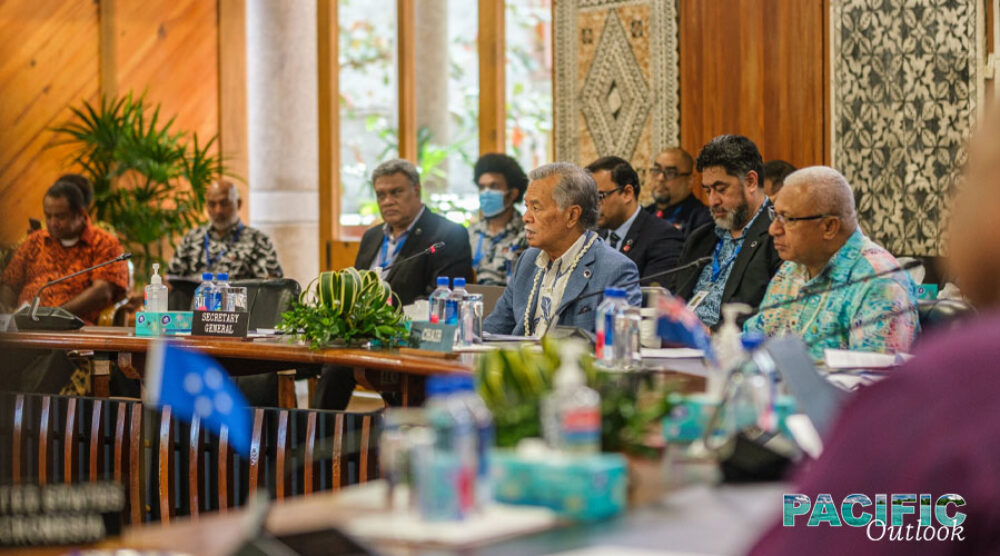While Pacific Island Countries (PICs) and Western nations rely on shared values as a basis for a strong relationship, Beijing relies on a different appeal—an “ability to deliver,” in Dame Meg Taylor’s words.
Indeed, across the Pacific, where ‘bricks and mortar’ outcomes face persistent setbacks, tangible deliverables are not just broadly appreciated but welcomed. Pacific nations have understandably intensified their relationships over the past decade and a half, based on the proposed ‘win-win’ nature of Chinese help.
However, it is here in this tension—between values and interests—where we see the need for ‘strategic cooperation’. Or, in other words, the potential for a blend between Western and Chinese forms of regional assistance. PICs—rather than being passive players – can play a key role in blending this assistance and shaping cooperation.
‘Strategic cooperation’ is defined by Kevin Rudd in The Avoidable War as “those areas where continued strategic cooperation (for example, on climate change) is both recognised and encouraged.”
There are two sub-elements to strategic cooperation relevant to the Pacific.
The first, as Rudd notes, is that strategic cooperation is essential in offsetting escalations between Beijing and Washington, and “navigating each other’s strategic redlines” and “mutually identifying the areas of nonlethal national security policy… where full-blown strategic competition is accepted as the new normal.”
PICs can play a unique role in terms of directing where and how such cooperation can take place, which empowers PICs and, at the same time, has the functional benefit of delivery.
Here we find the second sub-element of strategic cooperation in the Pacific—clear precedent. In terms of practical examples of cooperation, the region is not starting from scratch. The 2015 Australia-China-PNG malaria pilot control project is one small but important illustration. Another is the 2014 People’s Republic of China (PRC)-New Zealand-Cook Islands Water Partnership. The 2018 review of the Australia-China-PNG trilateral malaria project, in particular, noted the project was “a successful model of trilateral development cooperation” and that it “demonstrated the additional value made possible when these two donors [Australia and the PRC] work together in partnership with the PNG government. There would be merit in further application of this model.”
Although the projects are minor at this stage, PICs taking a greater role in directing strategic cooperation—in terms of priorities that are important to them—only enhances Taylor’s claim for the Blue Pacific Continent to continue its position as “a strategically important site of independence, sovereignty, and peace,” while remaining “friends to all.”
A final theme for PICs to consider as part of a framework for opportunity amid great power competition is capability. Both Taylor and the 2050 Strategy for the Blue Pacific Continent surprisingly fail to mention this word beyond single references.
Capabilities, however, will be essential in meeting localised responses to climate change. Its continual elevation as a principal security concern among Pacific leaders—in regional and international fora—is essential for political awareness and exposure.
At the same time, however, its elevation runs the risk of becoming scrutinised by Pacific citizens, who continually face localised climate-change-related environmental issues that rest on government capabilities and not international declarations or agreements. Regional examples include the management of displaced populations, environmental protection, forestry management and marine protection.
These issues, to speak frankly, are currently not well-managed by Pacific governments. Outside assistance in these areas—in which the US has taken a specific contemporary interest through its South Pacific Strategy and other agreements—should not be overlooked.
This perhaps will be the most important challenge for Pacific leaders that have endorsed the Blue Pacific—to match the Strategic Pathways of the grand 2050 Strategy for the Blue Pacific Continent (“governance; inclusion and equity; education, research and technology; resilience and wellbeing; and partnerships and cooperation”) to tangible outcomes for Pacific people.
Indeed, this will be important not just for Pacific political leaders but, in the words of Epeli Hauʻofa, “ordinary people,” who Hauʻofa noted in Our Sea of Islands “make decisions about their lives independently” and who sustain “skepticism about state policies and the like.”
The late Hauʻofa is often cited by Taylor and other regional leaders as articulating the spiritual basis for a Pacific-led regionalism. Any fair reading of his work and legacy will cite two themes he often returned to—a hostility to ‘belittlement’ and keeping Pacific people ‘in tiny spaces’.
A framework of opportunity now exists to avoid such things. And now offers a time for Pacific nations and people to lead in an authentic way in the age of great power competition.
AUTHOR
Sean Jacobs is a Port Moresby-born Australian writer, and government relations and policy specialist.








